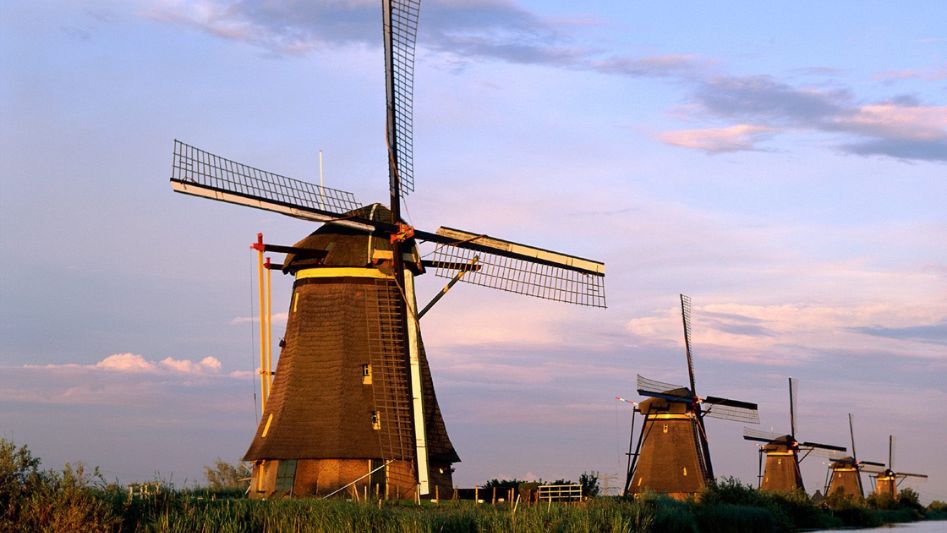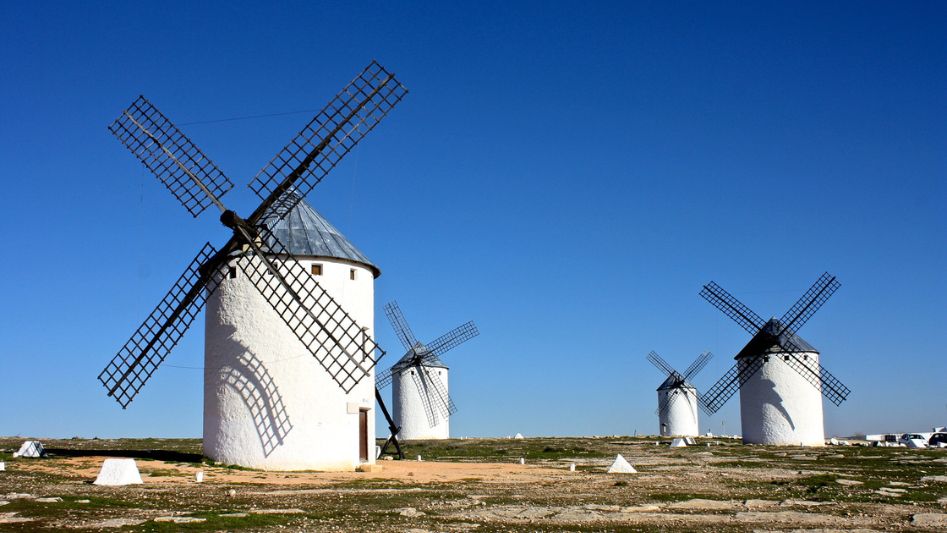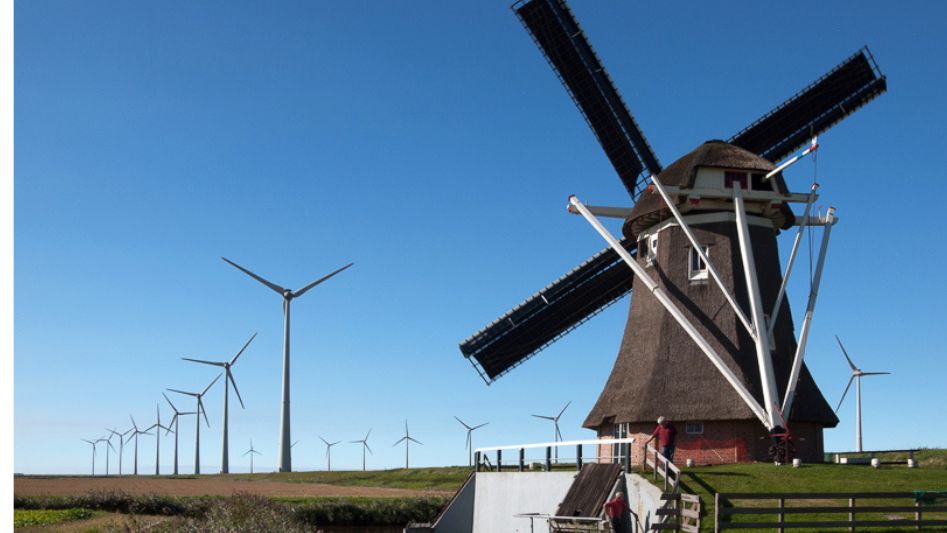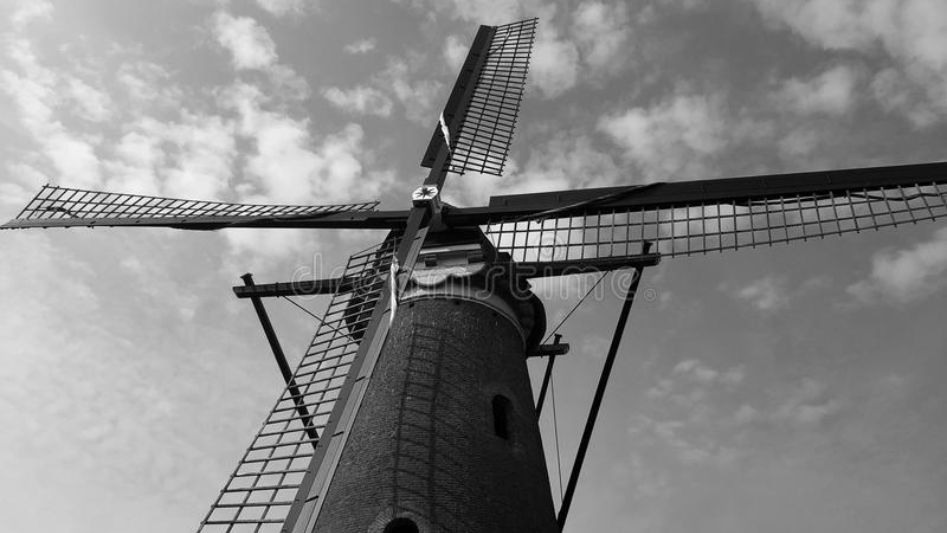Windmills are a type of traditional vertical axis wind turbine used for centuries to grind grain and pump water. They are also used to generate electricity, mill wood, and as decoration.
Table Of Content
A windmill is a device that harnesses the power of the wind by harnessing the wind’s energy via the use of sails that are mounted on a revolving shaft. The sails are either mounted at an angle or given a minor twist so that the force of the wind hitting them can be split into two parts, one of which, in the plane of the sails, transmits rotations. This allows the sails to more effectively generate rotation.

Windmills, much like waterwheels, were among the first prime movers that supplanted humans as a source of power. Other early prime movers included waterwheels. Beginning in the 12th century and continuing into the early 19th century, there was a steady increase in the number of windmills operating across Europe. Their gradual fall continued for another hundred years with the invention of steam power, which was the primary factor in their demise. Their rapid demise started after World War I with the advancement of the internal-combustion engine and the spread of electric power; however, ever since that time, electrical generation by wind power has served as the subject of an increasing number of experiments. Since then, considerable progress has been made in the field of wind powerupplanted humans as a source of power. Other early prime movers included waterwheels. Beginning in the 12th century and continuing into the early 19th century, there was a steady increase in the number of windmills operating across Europe. Their gradual fall continued for another hundred years with the invention of steam power, which was the primary factor in their demise. Their rapid demise started after World War I with the advancement of the internal-combustion engine and the spread of electric power; however, ever since that time, electrical generation by wind power has served as the subject of an increasing number of experiments. Since then, considerable progress has been made in the field of wind power. Considerable progress has been made in the field of wind power.
Both a Persian millwright in the year 644 A.D. and windmills in Seistan, Persia, in the year 915 A.D. are credited with being the first known references to windmills. These windmills are of the horizontal-mill type, which means that they have sails radiating from a vertical axis that is standing in a stationary building. The building contains ports for the input and exit of the wind that are diametrically opposite each other. The design of each mill is inspired by the design of the earliest water mills, and each mill directly drives a single pair of stones without the need for gears. Millwrights from Persia who were captured by Genghis Khan’s army were exiled to China to teach the locals how to construct windmills, and China has continued to rely on windmills as an effective method of irrigation ever since.

The horizontal sails on a vertical axis are a direct derivation of the Roman water mill, which had a right-angle drive to the stones by a single pair of gears. This straight derivation led to the development of the vertical windmill. The post mill is the name given to the very first version of the vertical mill. It features a body that is similar to a box and carries the sails. The body also contains the gearing, millstones, and equipment. On the level of the mill body’s second floor, it is affixed to a well-supported wooden post that is socketed into a horizontal beam. It is possible to turn it on this way so that the sails can be positioned so that they face the wind.
The subsequent step was to construct a tower that would hold the stones and the gearing in place. This has a moveable top, also known as a cap, that holds the sails and can be moved around on a track, also known as a curb, on top of the tower. The image of a tower mill that is considered to be the first one ever discovered dates back to about 1420. Post mills and tower mills were common throughout Europe, and early American settlers brought both types of mills to the New World.
In order for a windmill to function properly, its sails need to be oriented so that they face directly into the wind. Additionally, in the early mills, the rotation of the post-mill body or the tower-mill cap was accomplished manually by means of a long tailpole that extended all the way down to the ground. In the year 1745, an Englishman named Edmund Lee devised the automated fantail. This consists of a group of five to eight smaller vanes that are installed at right angles to the sails on the tailpole or ladder of a post mill and are connected by gearing to wheels that operate on a track around the mill. When the wind shifts direction, it pushes on the sides of the vanes, which in turn rotate them and, as a result, the track wheels, which in turn rotate the mill body. This continues until the sails are once again facing directly into the wind. In addition, the fantail can be attached to the caps of tower mills, and it will then drive down to a geared rack located on the curb.
A mill has its sails mounted on an axle, also known as a windshaft, which is tilted upward at an angle of between 5 and 15 degrees with respect to the horizontal. The initial sails for the mill consisted of wooden frames over which sailcloth was draped. When the mill was stopped, each sail was completed separately. In the beginning, sails were simply flat planes that were tilted at a fixed angle in relation to the direction of rotation. As time went on, however, sails began to be constructed with a twist similar to that of an aeroplane propeller.
In the year 1772, a Scotsman named Andrew Meikle devised the spring sail by exchanging the sailcloths with hinged shutters similar to those of a Venetian blind. These shutters were controlled by a linking bar and a spring that were attached to each sail. When the mill was stopped, each spring needed to have its tension changed in accordance with the amount of power that was necessary; after this was done, the sails were able to self-regulate to a certain extent.
In the year 1789, Stephen Hooper in England decided to use roller blinds rather than shutters for the mill’s windows. He also invented a remote control that allowed all of the blinds to be adjusted at the same time while the mill was operating. In the year 1807, Sir William Cubitt invented his “patent sail” by combining Meikle’s hinged shutters with Hooper’s remote control by chain from the ground via a rod passing through a hole drilled through the windshaft. The operation was similar to that of operating an umbrella, and the sails could be made to self-regulate by varying the weights that were hung on the chain.
Daniel Hallady introduced the annular-sailed wind pump to the United States in 1854, and its fabrication in steel by Stuart Perry in 1883 led to its adoption all over the world. Despite its low efficiency, the annular-sailed wind pump was widely used because it was inexpensive and dependable. The structure is made up of a number of small vanes that are arranged radially within a wheel. The yaw is governed by a tail vane, and the torque is governed by putting the wheel off-centre in relation to the vertical axis of the yaw. The government is automatic. Therefore, as the wind picks up, the mill will begin to rotate on its vertical axis. This will result in a decrease in the effective area, which will in turn result in a decrease in speed.
The grinding of grain was by far the most important application for the windmill. In some regions, the land drainage and water pumping applications of this technology were of equal importance. P. La Cour’s mill, which was constructed in Denmark in 1890 with patent sails and twin fantails on a steel tower, was the first windmill to be used as a source of electrical power. Since then, windmills have continued to be used in this capacity. In the 1970s, there was a resurgence in people’s interest in the use of windmills for the generation of electric power, both on a single-user and commercial scale.
Conclusion
A windmill is a device that harnesses the power of the wind by harnessing the wind’s energy via the use of sails that are mounted on a revolving shaft. Both a Persian millwright in the year 644 A.D. and windmills in Seistan, Persia, in the year 915 A.D. are credited with being the first known references to windmills. The subsequent step was to construct a tower that would hold the stones and the gearing in place. This has a moveable top, also known as a cap, that holds the sails and can be moved around on a track, also known as a curb, on top of the tower. The sails of a mill are positioned on an axle, also known as a windshaft, which is tilted upward at an angle that ranges from 5 degrees to 15 degrees with respect to the horizontal. The early mill sails were made of wooden frames that were draped with sailcloth; each sail was set individually while the mill was stopped.

FAQs
Where can I find out more about the history of the windmill?
The horizontal, or “panemone,” windmill initially appeared in Greater Iran during the 9th century, while the vertical windmill first appeared in northwest Europe during the 12th century. Windmills were utilised throughout the high mediaeval and early modern periods.
Who was the first person to invent the windmill?
Daniel Halladay, a machinist, inventor, and businessman, received a patent for the first windmill that was economically feasible on August 29, 1854. This windmill was called Halladay’s Self-Governing Windmill. John Burnham, a local Ellington businessman, had reached out to Halladay in the hopes of recruiting him to work on the design.
What are the three primary categories of wind power?
Wind Power on a Utility Scale This describes wind turbines with power outputs ranging from 100 kilowatts to several megawatts, which feed electricity into the power grid and are run by electric utilities or power operators, who then provide it to the end customer.
Wind from the Ocean; Distributed or “Small” Wind; Offshore Wind
How tall is a windmill, typically?
Wind turbines are enormous. The typical length of a wind turbine blade is 200 feet, while the average height of a wind turbine tower is over 300 feet. This is approximately the height of the Statue of Liberty. In addition, the average nameplate capacity of turbines is growing, which indicates that these machines have increasingly potent generators.
You May Also Like
- Wind Energy Turbines History
- Wind Turbines For At Home: Benefits and Challenges
- Vertical Axis Wind Turbines Will Dominate The Floating Offshore Wind Market
- Why Wind Turbines Need Gear Boxes?
- What Is A Helical Wind Turbine?

